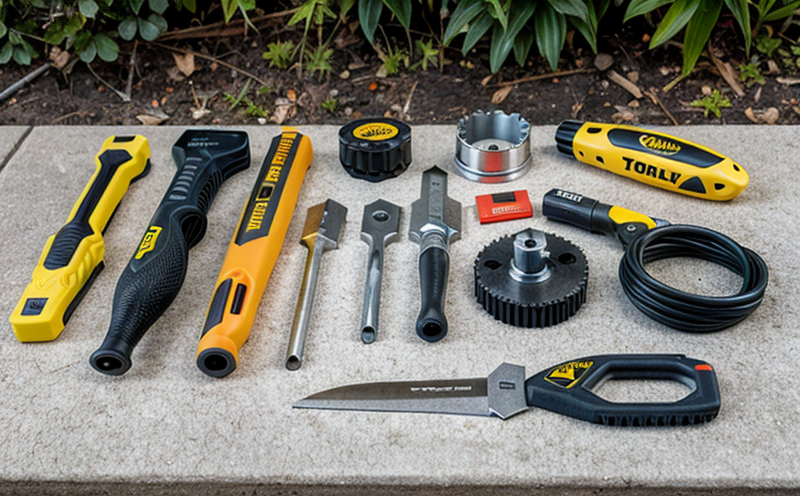Water Ingress Testing of Outdoor Tools
The water ingress testing of outdoor tools is a critical procedure that ensures products are robust and safe under various environmental conditions. Outdoor tools, especially those used in harsh weather or moisture-prone areas, must resist water intrusion to prevent malfunctions and ensure user safety.
Water ingress can lead to numerous issues such as short-circuiting, corrosion, and reduced performance of electronic components within the tool. The test simulates real-world conditions where tools are exposed to rain, dew, or other forms of moisture. This testing is particularly important for products like cordless drills, lawn mowers, and garden shears.
The process involves subjecting the specimen to a controlled environment that mimics different levels of water exposure. The test can be conducted in various stages, starting with low-pressure sprays and progressing to higher pressures until a specified ingress level is achieved or exceeded. This ensures that the tool's sealing effectiveness is thoroughly evaluated.
Testing procedures are standardized by several international bodies such as ISO 20655:2012 (ISO/TC 43 SC 7) and IEC 60529, which classify protection levels against foreign objects and water. These standards provide a framework for determining the ingress protection rating IP code.
For tools with electronic components, such as those found in cordless drills or battery-powered lawn mowers, the test also evaluates the integrity of the power supply and control circuits. This involves checking the insulation resistance between conductive parts and the housing to ensure that no water has compromised the electrical safety.
The specimen preparation for this testing can vary depending on the tool type. For instance, a cordless drill might have its battery removed during testing to focus solely on the mechanical aspects of ingress protection. Garden shears may require different preparations to account for their blade and handle integration. The test setup typically includes a controlled environment chamber where the specimen is exposed to water under specific pressure and duration.
The acceptance criteria are stringent, with tests often requiring tools to pass multiple stages without any signs of ingress or damage. Compliance with these standards not only ensures product reliability but also enhances consumer trust by meeting regulatory requirements set forth by bodies like OSHA (Occupational Safety and Health Administration) in the U.S.
Failure to meet water ingress testing requirements can lead to product recalls, legal liabilities, and reputational damage. Therefore, this test is a crucial step in the development and quality assurance process of outdoor tools.
Applied Standards
| Standard | Description |
|---|---|
| ISO 20655:2012 | This standard specifies the test methods and criteria for determining the resistance of electrical enclosures to the ingress of water. |
| IEC 60529 | International Electrotechnical Commission's standard on protection ratings, which includes IP codes detailing degrees of protection against solid foreign bodies and liquids. |
| EN 60529:2013 | This European standard provides a harmonized approach to the IEC 60529, ensuring consistency in testing methods across Europe. |
Why Choose This Test
Water ingress testing of outdoor tools is essential for several reasons. Primarily, it enhances product durability and reliability by ensuring that the tool can withstand exposure to moisture without compromising performance or user safety.
From a compliance perspective, this test ensures that products meet industry standards and regulations, thereby avoiding potential legal issues and product recalls. It also improves brand reputation by demonstrating commitment to quality and consumer safety.
The test is particularly beneficial for R&D engineers who can use the results to refine designs and materials used in tool construction. For quality managers and compliance officers, this testing provides a clear pathway to ensure that products are fit for purpose and meet market expectations.
In addition, water ingress testing supports procurement teams by providing data on supplier performance and material integrity. This information can be crucial when selecting suppliers or negotiating contract terms with existing partners.
International Acceptance and Recognition
The water ingress test is widely accepted across various countries and industries due to its universal applicability in ensuring product reliability. The global recognition of standards like ISO, IEC, and EN ensures that the testing results are valid and comparable internationally.
Many countries have adopted these standards as part of their national regulations for electrical products. For instance, in the United States, OSHA has incorporated these standards into its safety guidelines. In Europe, conformity to these standards is a requirement for placing products on the market under the Low Voltage Directive (LVD).
The harmonization of these tests across different regions simplifies compliance processes for manufacturers and importers. It also promotes trade by ensuring that products meet similar quality benchmarks regardless of their point of origin.





